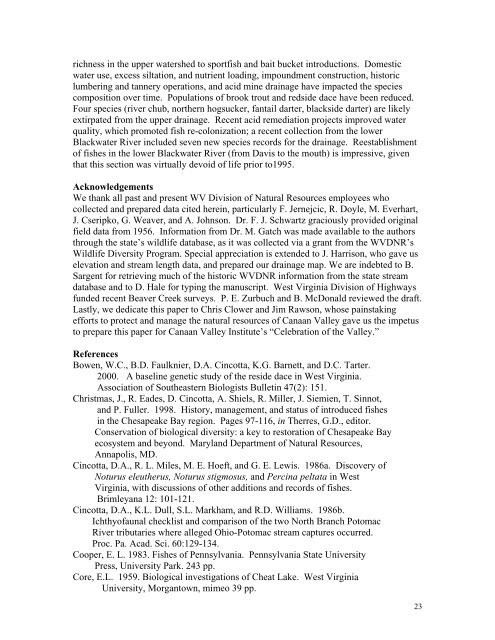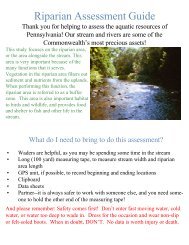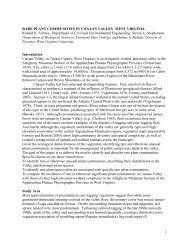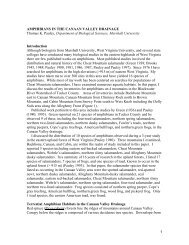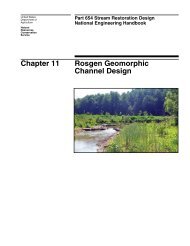FISHES OF THE BLACKWATER RIVER DRAINAGE, TUCKER ...
FISHES OF THE BLACKWATER RIVER DRAINAGE, TUCKER ...
FISHES OF THE BLACKWATER RIVER DRAINAGE, TUCKER ...
Create successful ePaper yourself
Turn your PDF publications into a flip-book with our unique Google optimized e-Paper software.
ichness in the upper watershed to sportfish and bait bucket introductions. Domesticwater use, excess siltation, and nutrient loading, impoundment construction, historiclumbering and tannery operations, and acid mine drainage have impacted the speciescomposition over time. Populations of brook trout and redside dace have been reduced.Four species (river chub, northern hogsucker, fantail darter, blackside darter) are likelyextirpated from the upper drainage. Recent acid remediation projects improved waterquality, which promoted fish re-colonization; a recent collection from the lowerBlackwater River included seven new species records for the drainage. Reestablishmentof fishes in the lower Blackwater River (from Davis to the mouth) is impressive, giventhat this section was virtually devoid of life prior to1995.AcknowledgementsWe thank all past and present WV Division of Natural Resources employees whocollected and prepared data cited herein, particularly F. Jernejcic, R. Doyle, M. Everhart,J. Cseripko, G. Weaver, and A. Johnson. Dr. F. J. Schwartz graciously provided originalfield data from 1956. Information from Dr. M. Gatch was made available to the authorsthrough the state’s wildlife database, as it was collected via a grant from the WVDNR’sWildlife Diversity Program. Special appreciation is extended to J. Harrison, who gave uselevation and stream length data, and prepared our drainage map. We are indebted to B.Sargent for retrieving much of the historic WVDNR information from the state streamdatabase and to D. Hale for typing the manuscript. West Virginia Division of Highwaysfunded recent Beaver Creek surveys. P. E. Zurbuch and B. McDonald reviewed the draft.Lastly, we dedicate this paper to Chris Clower and Jim Rawson, whose painstakingefforts to protect and manage the natural resources of Canaan Valley gave us the impetusto prepare this paper for Canaan Valley Institute’s “Celebration of the Valley.”ReferencesBowen, W.C., B.D. Faulknier, D.A. Cincotta, K.G. Barnett, and D.C. Tarter.2000. A baseline genetic study of the reside dace in West Virginia.Association of Southeastern Biologists Bulletin 47(2): 151.Christmas, J., R. Eades, D. Cincotta, A. Shiels, R. Miller, J. Siemien, T. Sinnot,and P. Fuller. 1998. History, management, and status of introduced fishesin the Chesapeake Bay region. Pages 97-116, in Therres, G.D., editor.Conservation of biological diversity: a key to restoration of Chesapeake Bayecosystem and beyond. Maryland Department of Natural Resources,Annapolis, MD.Cincotta, D.A., R. L. Miles, M. E. Hoeft, and G. E. Lewis. 1986a. Discovery ofNoturus eleutherus, Noturus stigmosus, and Percina peltata in WestVirginia, with discussions of other additions and records of fishes.Brimleyana 12: 101-121.Cincotta, D.A., K.L. Dull, S.L. Markham, and R.D. Williams. 1986b.Ichthyofaunal checklist and comparison of the two North Branch PotomacRiver tributaries where alleged Ohio-Potomac stream captures occurred.Proc. Pa. Acad. Sci. 60:129-134.Cooper, E. L. 1983. Fishes of Pennsylvania. Pennsylvania State UniversityPress, University Park. 243 pp.Core, E.L. 1959. Biological investigations of Cheat Lake. West VirginiaUniversity, Morgantown, mimeo 39 pp.23


